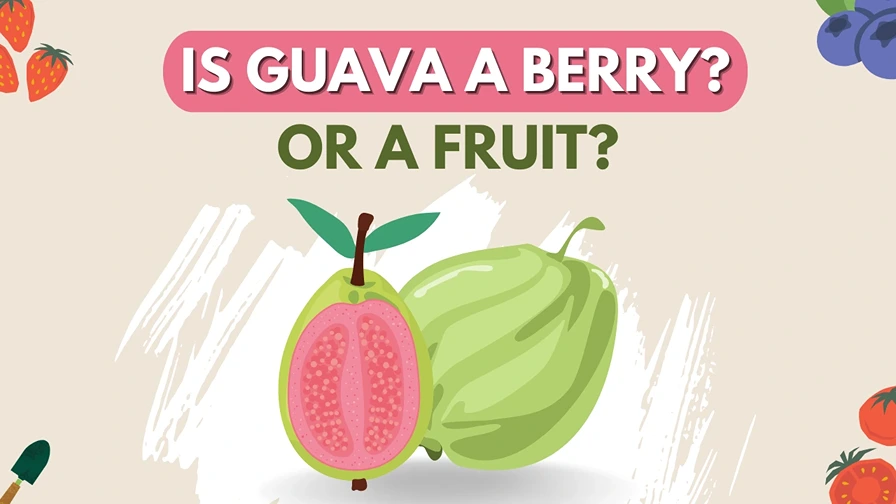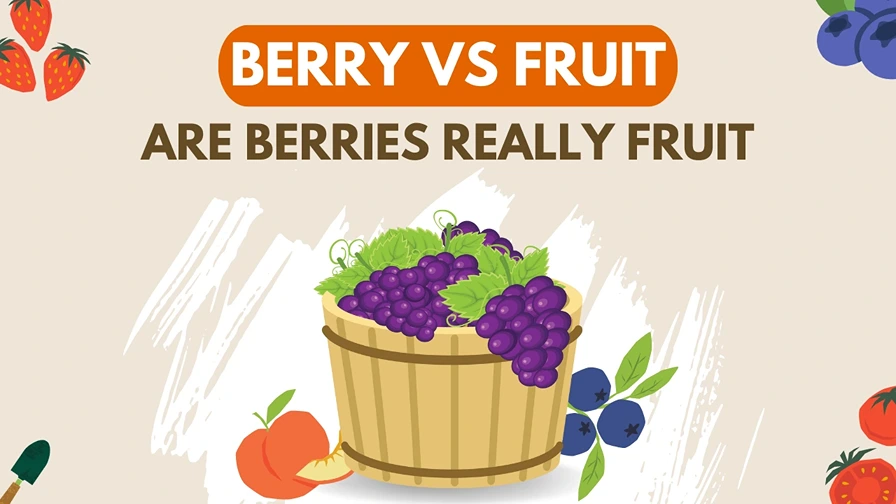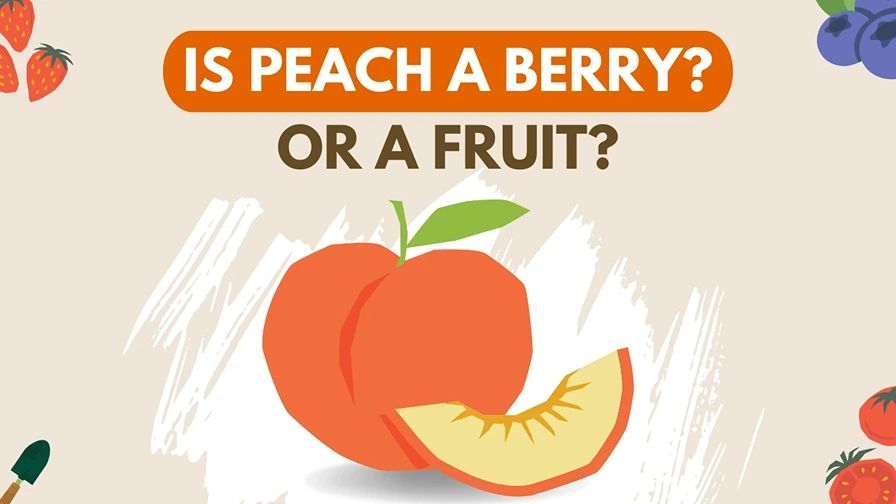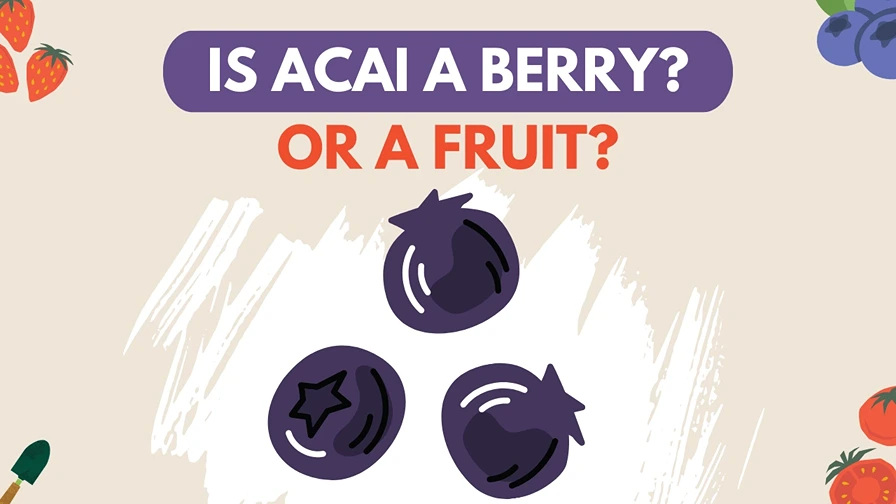A single guava fruit can contain as many as 100-500 edible seeds, depending on the variety. These hard seeds are covered with juicy and sweet pulp, which is loved by all of us. But how often have you thought that having these many seeds makes Guava a berry or a fruit?
To provide you with a simple explanation – Guava is a berry and not a typical fruit.
But why is guava a berry and not a fruit? And what makes guava a berry?
Let’s explore each question and find out where guava stands in this berry vs fruit debate.
What is a Guava?
Guava refers to the delicious and aromatic fruit that grows on the guava tree, scientifically known as Psidium guajava. The guava tree is native to tropical regions and is widely cultivated for its flavorful fruits.
The guava tree belongs to the Myrtle family, Myrtaceae. It typically reaches a height of 6 to 33 feet (2 to 10 meters), although some varieties can grow even taller under favorable conditions. The tree has a compact and bushy appearance, with numerous branches and glossy green leaves.
The leaves of the guava tree are leathery, oval-shaped, and possess a strong aromatic scent when crushed. They are arranged opposite each other along the branches and have prominent veins. The presence of these distinct leaves is one of the identifying features of guava trees.
Flowers and Reproduction
Guava trees produce small, white flowers with numerous stamens and a central pistil. These flowers are typically solitary or found in clusters in the leaf axils.
The flowers have a delicate fragrance that attracts various pollinators, such as bees and butterflies. The pollination process enables the production of fruits.
Interestingly, guava trees can self-pollinate, which means they can produce fruits without relying on external pollinators. This self-fertilization mechanism contributes to the tree’s reproductive success and ensures a higher chance of fruit production even in areas with limited pollinator activity.
Fruits: Structure and Characteristics
The guava fruit is a fleshy, indehiscent (not splitting open at maturity) structure that develops from the ovary of the flower.
It has a rounded or oval shape and a varying size, depending on the variety. The skin of the fruit is typically thin, but it can be tough in some cultivars.
One notable characteristic of guava fruits is the presence of numerous small seeds embedded within the flesh. These seeds are generally hard and numerous, giving the fruit a unique texture when consumed.
The color of the guava flesh ranges from white to pink, depending on the cultivar and ripeness.
Another captivating aspect of guava is its enticing aroma. The fruit emits a sweet, tropical fragrance that is often described as a delightful blend of pear, banana, and passion fruit.
When you cut open ripe guava, its aroma fills the air, instantly invoking a sense of tropical paradise.
Varieties of Guava
Guava comes in a variety of cultivars, each with its unique characteristics. Some popular guava varieties include:
- Common Guava (Psidium guajava): This is the most widely recognized variety, with green or yellow skin and white to pink flesh. It has a sweet flavor with a hint of tartness.
- Strawberry Guava (Psidium littorale): Also known as Cattley guava, this variety is smaller in size and has reddish skin. The flesh is typically pink and has a distinctly sweet and tangy flavor reminiscent of strawberries.
- Pineapple Guava (Feijoa sellowiana): Although technically not a true guava, this fruit is often referred to as guava due to its similar characteristics. It has green skin and a unique flavor profile that combines pineapple, mint, and guava, resulting in a delightful and refreshing taste.
Culinary Uses
Guava is a versatile fruit that can be enjoyed in various culinary preparations. Its delightful flavor and aromatic qualities make it a popular choice for both sweet and savory dishes. Here are some common ways guava is used:
- Fresh Consumption: Guavas can be eaten fresh, simply by slicing them open and scooping out the flesh. The fruit can be enjoyed as a healthy snack or added to fruit salads for a burst of tropical flavor.
- Juices and Smoothies: Guava juice and smoothies are a refreshing and nutritious way to savor the fruit. The juice can be extracted by blending or pressing the guava pulp and combining it with other fruits for a delightful tropical drink.
- Jams and Preserves: Guava’s natural sweetness and pectin content make it an excellent fruit for making jams, jellies, and preserves. The fruit’s unique flavor shines through in these spreads, adding a tropical twist to breakfast toast or pastries.
- Desserts: Guava is a delightful addition to desserts, ranging from pies and tarts to cakes and ice creams. Its sweet and tangy flavor pairs well with other fruits, custards, and creamy textures, creating a delectable treat for any sweet tooth.
Nutritional Value
Beyond its botanical description, guava also boasts a range of nutritional benefits. It is a rich source of various vitamins and minerals, making it a valuable addition to a healthy diet. Here are some key nutrients found in guava:
- Vitamin C: Guava is renowned for its high vitamin C content. It provides a significant portion of the daily recommended intake, contributing to immune system support and overall health.
- Dietary Fiber: Guava contains a good amount of dietary fiber, which aids in digestion and helps maintain healthy bowel movements.
- Antioxidants: The fruit is packed with antioxidants, such as lycopene and flavonoids, which help protect the body against cellular damage caused by free radicals.
- Minerals: Guava is a source of essential minerals like potassium, magnesium, and manganese, which are important for maintaining optimal bodily functions.
With the understanding of the guava’s botanical description, we can now move forward to explore the intriguing question of whether guava is a berry or a fruit. Let’s uncover the truth behind this classification conundrum.
Why Guava is a Berry
When examining the botanical classification of guava, it is very clear that guava is indeed a berry. Let’s explore the reasons why guava fits the characteristics of a berry.
Botanical Definition of a Berry
In botanical terms, a berry is a fleshy fruit that develops from a single ovary and has multiple seeds embedded within the flesh. Berries are typically small, juicy, and have a soft pericarp (the fruit wall).
Guava’s Ovary and Fruit Structure
Guava aligns with the definition of a berry because it originates from a single ovary and possesses the key characteristics associated with berries.
Each guava fruit develops from the ovary of a guava flower, which undergoes fertilization and subsequent fruit formation.
In guava, the fleshy part we consume constitutes the pericarp of the fruit.
When you cut open guava, you will notice the numerous small seeds distributed throughout the flesh. These seeds are the result of sexual reproduction, where pollen from the stamens fertilizes the ovules in the ovary.
Seed Distribution
Another aspect supporting guava’s classification as a berry is the distribution of its seeds.
In a true berry, the seeds are spread throughout the flesh, as is the case with guava. Each guava fruit contains multiple small seeds evenly distributed within its succulent flesh.
This distribution of seeds aligns with the botanical definition of a berry.
Fleshy and Succulent Nature
Guava’s fleshy and succulent nature is another characteristic reminiscent of berries.
Like berries, guava has a soft pericarp, giving it a juicy and moist texture when ripe. This fleshy quality contributes to the overall appeal and enjoyment of consuming guava.
Proved: Guava is a Berry
Considering the botanical definition of a berry, guava ticks many of the boxes.
Guava develops from a single ovary, contains multiple seeds embedded within its flesh, and exhibits a fleshy and succulent texture. These characteristics align with the typical traits associated with berries, making a strong case for guava’s classification as a berry.
While the debate surrounding guava’s categorization as a berry or a fruit continues, the berry argument stands on solid ground.
However, to gain a comprehensive understanding, we must also explore the opposing perspective. In the next section, we will delve into why guava is not classified as a fruit. Let’s unravel this intriguing botanical puzzle further.
Guava: Not Your Typical Fruit
While some argue that guava can be classified as a berry, there is an opposing perspective that views guava as distinct from typical fruits. Let’s delve into the reasons why guava is not considered a conventional fruit.
Botanical Classification of Fruits
In botanical terms, fruits encompass a diverse range of structures that develop from the ovary of a flowering plant. They can vary significantly in size, shape, and composition. From berries to drupes, all come under the category of fruit. Examples of typical fruits are peach, apple, mango, plum, etc.
Guava’s Deviation from Typical Fruit Characteristics
When comparing guava to the characteristics commonly associated with fruits, some noticeable distinctions arise:
- Seed Distribution: Unlike many fruits, guava does not have seeds concentrated in a central core or specific location within the fruit. Instead, the small seeds are scattered throughout the flesh, more akin to the distribution found in berries.
- Pericarp Composition: While most fruits possess a distinct pericarp that surrounds the seed(s), guava’s pericarp is relatively thin and less distinguishable. In comparison to fruits like apples or oranges, where the pericarp is clearly discernible, guava’s pericarp is less prominent.
- Size and Shape Variability: Guava exhibits a wide range of sizes and shapes, depending on the variety and ripeness. This variability in appearance is less common among typical fruits, which often have more consistent size and shape characteristics within a specific fruit type.
Proved: Guava Isn’t A Typical Fruit
Although guava shares some characteristics with conventional fruits, it deviates in significant ways, leading to its exclusion from the standard fruit classification. The dispersed seed distribution, the less pronounced pericarp, and the variability in size and shape contribute to the guava’s distinctiveness as a fruit.
Common Fruits That Are Berries In Disguise
While the classification of guava as a berry is clear but just like guava there are other fruits that are classified as berries but are commonly referred to as typical fruits.
Let’s explore some examples of these fruits, which exhibit berry characteristics but are not commonly recognized as such.
Tomatoes: A Surprising Berry
Yes, you read it correctly! Botanically speaking, tomatoes are classified as berries. They develop from a single ovary, contain numerous seeds within the fleshy pulp, and possess a soft pericarp. However, due to their culinary usage and savory flavor profile, tomatoes are commonly considered vegetables rather than berries in everyday parlance.
Bananas: A Familiar Fruit with a Berry Identity
Bananas, often associated with tropical vibes and a staple in many households, also fall into the botanical definition of berries. They develop from a single ovary, have seeds (tiny and vestigial) embedded within the flesh, and possess a soft pericarp. Yet, bananas are typically referred to as typical fruits, and their classification as berries may come as a surprise to many.
Kiwifruits: Tiny Berries in Disguise
Kiwifruits, with their fuzzy brown exterior and vibrant green flesh, are another example of fruits that are botanically classified as berries. They develop from a single ovary, have numerous small seeds distributed throughout the flesh, and possess thin and edible skin. However, due to their larger size and unique appearance, they are commonly recognized and referred to as typical fruits.
Grapes: Miniature Berry Clusters
Grapes, beloved for their juicy and sweet taste, are another intriguing example. While we often think of grapes as a distinct fruit type, they are, in fact, botanically classified as berries. They develop from a single ovary, contain multiple seeds within the flesh, and are characterized by a soft and edible pericarp. Their clustered growth pattern further reinforces their berry identity.
Conclusion
In conclusion, the question of whether guava is a berry or a fruit has been a topic of debate for many years.
However, according to the botanical definition, guava is indeed a berry, due to its fleshy pulp, numerous seeds, and soft pericarp.
Although it may not fit our everyday definition of a berry, its classification as such is based on scientific criteria.
As we conclude this, I hope you have gained a deeper appreciation for guava’s intriguing nature, and perhaps the next time someone asks, “Is guava a berry or a fruit?” you’ll be equipped with the knowledge to engage in a delightful discussion on this botanical puzzle.





